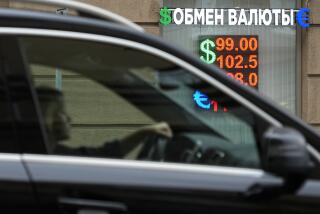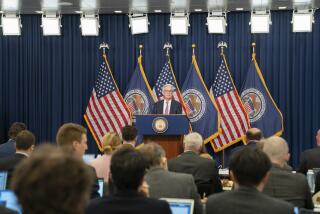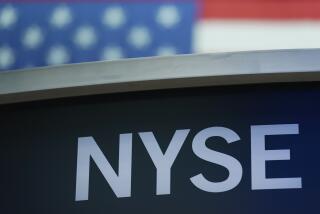Dollar’s Slide Arrested by Major Central Banks : Fed, Allies Buy $800 Million to Keep Value of Currency Within Target Ranges; Stocks Advance
- Share via
WASHINGTON — A coordinated sortie by major central banks to arrest the latest slide in the value of the dollar apparently succeeded Thursday, but analysts said that the U.S. currency probably will remain vulnerable to attack for the foreseeable future.
In a visible--and at least temporarily successful--move, central banks of the United States and its major economic allies intervened heavily in global foreign exchange markets Thursday, jointly buying an estimated $800 million to help prop up the price of the currency.
Help From Japan, Britain
Traders estimated that the United States, acting through the Federal Reserve, bought about $250 million. Also buying dollars were the central banks of Japan, West Germany, Britain, France and Italy.
Analysts said that the heavy buying--the first concerted effort by the central banks since the latest dollar slide began--was intended to signal that the ranges set for the value of the dollar by the major governments last summer are still in effect and will be enforced.
The signal, which was just what the markets had been waiting for, apparently worked. After rising in mid-morning, the U.S. currency closed in New York at 122.155 Japanese yen and 1.7230 West German marks--the bottom of the ranges set by the central banks.
The stock market also recovered. On Thursday, the Dow Jones Industrial Average closed up 13.87 points at 2,052.45, reversing a weeklong decline that had ended in a sharp 38.59-point slide Wednesday.
“The markets had been trying to test the resolve of the central banks--well, I think we’ve had a test with a capital T,” said Ellen Evans, a financial markets specialist at Salomon Bros., the large New York investment banking firm.
Nevertheless, forecasters were skeptical that the uneasy truce between governments and markets would last. David Hale, economist for Kemper Financial Services in Chicago, predicted that the intervention “will be effective for a few days, but they will test it again next week.”
Salomon Bros.’ Evans agreed. “I’m not convinced that the pressure on the dollar is off,” she said.
Analysts predicted that, in the short term, traders probably will focus next on the government’s November unemployment report, which is expected to provide an indication of how well the U.S. economy is performing. The figures are scheduled to be published on Dec. 2.
If job growth in November proves to have been excessively strong, the markets could become fearful that the economy is overheating and that the Fed will raise interest rates to help slow it down. Still, too sluggish a performance may provoke fears of recession.
Over the longer run, however, the bigger questions are whether the White House and Congress can come up with a credible plan to reduce the budget deficit and how rapidly the U.S. trade deficit continues to shrink.
Traders will also be watching to see how the economic team being put together by the incoming Bush Administration seems to function. So far, Bush has nominated only two members--Treasury Secretary Nicholas F. Brady and Secretary of State James A. Baker III.
The bearishness in the financial markets appears to have taken top government policy-makers by surprise. Until a few days ago, the dollar had been relatively stable.
But investors suddenly became nervous after the election and anxious about whether the United States and allied governments would continue to support the dollar.
More to Read
Inside the business of entertainment
The Wide Shot brings you news, analysis and insights on everything from streaming wars to production — and what it all means for the future.
You may occasionally receive promotional content from the Los Angeles Times.










